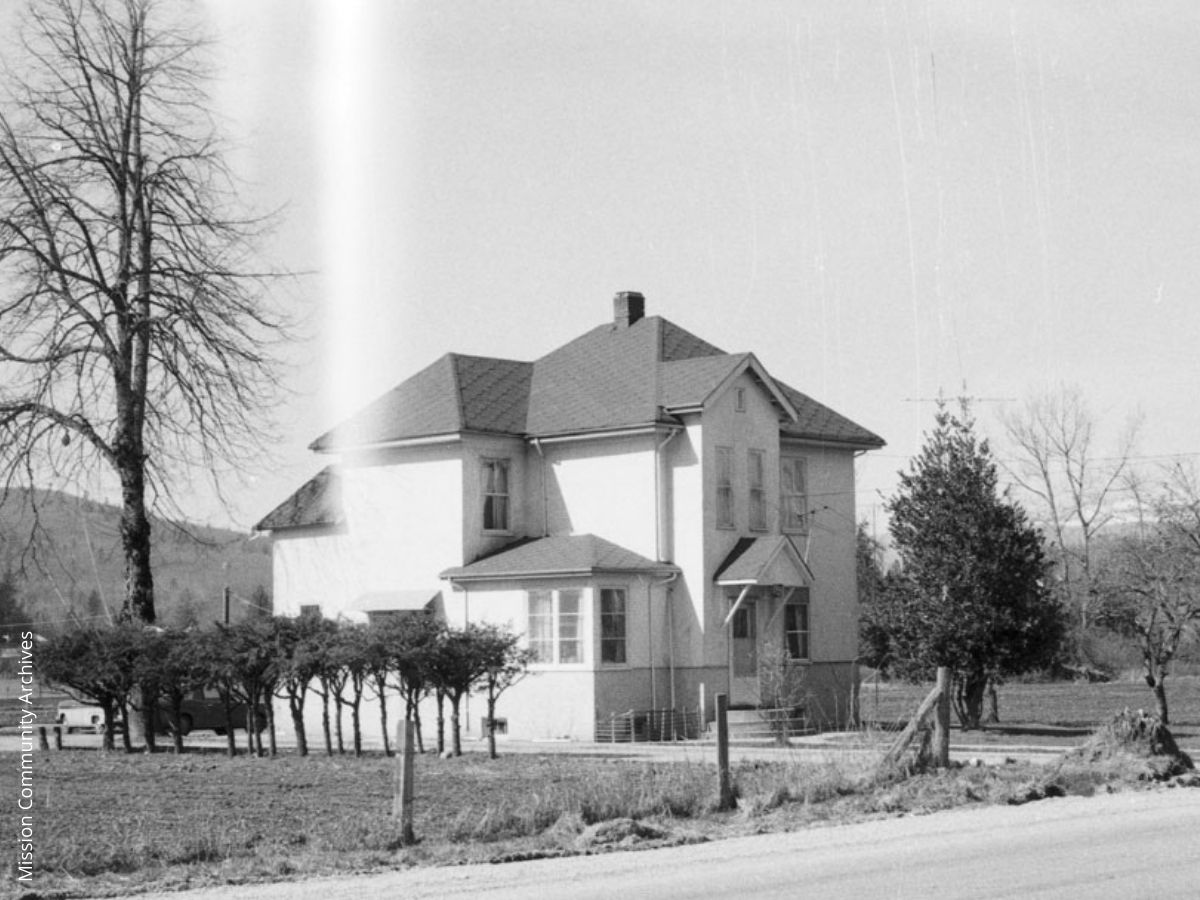Abbott Farm House
Location:
8423 Cedar Street
Resource Type:
Residential
Historic Neighborhood:
Cedar Valley
Current Occupant:
Private
Date of Construction:
1896
Site Description:
Large 2 ½ story house on the flat lot at the north-west corner of Cedar Street and Cherry Avenue; renovated with new siding, windows, etc. The original farmhouse is scarcely visible beneath the modernization.
Site History:
Edward James Abbott was a fruit grower, businessman, and inventor who arrived in Mission from Ontario in 1895 with his wife Charlotte Anne Abbott, his son Cephas, and two daughters Mina and Ira. Edward and his family stayed with his sister Mary (married to Tom Cox) and her family until his family’s first house was built on the property he had purchased on the corner of Cedar Street and Cherry Avenue. At the time, this was a long way from the downtown core of Mission.
Originally, Edward’s property at Cherry and Cedar was so heavily forested that Edward exclaimed to his wife, “if I ever get you up there I may never get you out.”1 But Edward did eventually clear the land and a house was finished in 1896. This farmhouse still stands, has been modernized, and much of the original farmland has been subdivided. The farm became one of the most productive berry farms in the municipality. Etta Abbott the youngest daughter of Edward and Charlotte Abbott was born in this farmhouse in 1901.
“When building the house Edward had arranged with a sawmill in New Westminster to send the lumber up the river to Mission on a paddle wheeler boat. Edward also arranged for the Captain of the boat to blow its whistle a prearranged number of times when rounding the Silverdale bend near the mouth of Silver Creek just west of Mission proper. This was to alert Edward and his neighbors to the delivery so they then hitched up their teams to wagons and went down to the Mission wharf to pick up the lumber.” 1
In 1910 Edward built the family’s second Mission home on another piece of property he owned close to town at Seattle (now 3rd Avenue) and Grand Street and the family proceeded to live there. The house and 10-acre farm at Cedar and Cherry were rented/leased out until just after Edward’s death in 1933 when it was sold.
People Associated with the Site:
Charlotte Ann Abbott (Snelgrove) came to Mission with her husband, son and two daughters in 1895.
George Abbott, brother of Edward Abbott, married Agnes Gibbard. He began as a berry farmer but became the proprietor of a hardware/harness store and a plumbing business.
Mary Jane Abbott came to the area in 1891, four years before her brother Edward; she was married to Thomas Josiah Cox, who operated a clothing store near the wharf on Harbour Avenue, then moved it up to Washington Street after the 1894 flood. Their son Rex Cox (d. 2009) also established a clothing store.
Etta Abbott was the youngest daughter of Edward and Charlotte Abbott and was born in the farmhouse in 1901. She married Andrew McRae. They had three children, Edward, Mildred, and Lois, who were raised at the 3rd Avenue family residence.2
Architectural Features:
The Abbott farmhouse was a two-story building with a wood frame and had an east-facing front verandah. It was designed in the style of a typical “Ontario house”. It was built with sawn lumber and hand-hewn cedar from New Westminster that was transported up the river.
“Much of the decorative woodwork inside and outside the house was hand-cut by Edward from cedar which abounded in the area. Whether any of the hand-cut woodwork was preserved during extensive renovations is not known.”1 At one point between tenants, Mildred Vollick (Edward’s granddaughter) remembers being inside the Cedar Street home and remembers the hand-cut cedar staircase and bannister to the second floor.
The house has seen extensive renovations and its appearance has changed considerably from the original construction.
Landscape:
Originally, there were ten acres of farmland where berries and fruits were grown. “Like most farmers, he [Abbott] grew a particular variety of strawberry called the ‘Victoria’, which was later renamed the ‘British Sovereign’. This particular stock dominated the berry industry in Mission for over 30 years, being cherished for its sweet, hairless fruit that ripened from the outside in, as well as its exceptionally prolific plants that were capable of producing five tons of berries per acre.”3
In 1908 Edward James Abbott showed the diversity of his products with this harvest report:
“Strawberries – 1900 cases of 24 boxes each; Raspberries – 1900 cases of 24 boxes each;
Blackberries – 900 cases of 24 boxes each; Rhubarb – 5 tons, 250 boxes of 40 pounds each; Plums – 5 tons, 500 crates of 20 pounds each; Apples – 200 boxes of 40 pounds each; Crabapples – 54 boxes of 40 pounds each; Pears – were a failure this season Cherries, currants and peaches – 30 cases
Gross value, a little over $5000. Strawberries being very low in price this year cut down about $2000.”3
The property has since been subdivided and is now surrounded by suburbs rather than farmland.
Additional Information:
Mission Community Archives
- BPA 490, Cherry Avenue Section
- Community Reference File 702.20/ABB1
- Fraser Valley Record. March 7, 1984. “Historic Abbott house.”
- Vollick, Mildred. Oral History. 2008
Virtual Museum of Canada
- Community Memories: Mission Farms & Farmers, slides 190-199.
Mission Museum
- Mission Farms & Farmers
–
1Fraser Valley Record March 7, 1984
2 McRae Residence profile
3 Mission Museum, “Mission Farms & Farmers” – Berry Section


